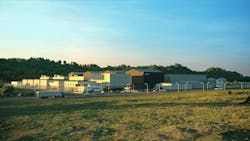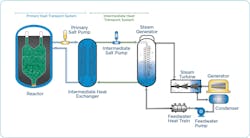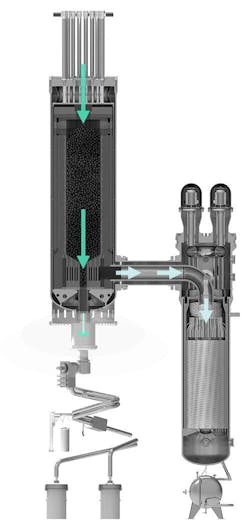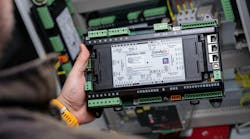Google and Amazon Make Major Inroads with SMRs to Bring Nuclear Energy to Data Centers
It’s been an exciting week for the nuclear small modular reactor (SMR) business and the foremost data center hyperscalers. Let's take a look at Google and Amazon's latest announcements toward their pursuit of clean energy for purposes of net zero, carbon-free cloud and AI infrastructure expansion.
Google and Kairos Power
First, Google and Kairos Power have announced an agreement to eventually build up to seven SMRs providing up to 500 MW of power, with the first unit to come online in 2030, and the project to be completed by 2035.
As Google's Senior Director of Energy and Climate, Michael Terrell said in his blog post, “To accelerate the clean energy transition across the U.S., we’re signing the world’s first corporate agreement to purchase nuclear energy from multiple small modular reactors (SMR) to be developed by Kairos Power.”
Terrell added, "This agreement is a key part of our effort to commercialize and scale the advanced energy technologies we need to reach our net zero and 24/7 carbon-free energy goals and ensure that more communities benefit from clean and affordable power in the future."
According to Kairos, a Master Plant Development Agreement was signed with Google which will lead to the deployment of multiple power generation systems, starting with an iterative demonstration strategy for their technology, leading up to the first commercial deployment in 2030.
Under the contract, Kairos Power will develop, construct, and operate a series of advanced reactor plants and sell energy, ancillary services, and environmental attributes to Google under Power Purchase Agreements (PPAs). Plants will be sited in relevant service territories to supply clean electricity to Google data centers.
Mike Laufer, Kairos Power's CEO and co-founder, said of this strategy, “Our partnership with Google will enable Kairos Power to quickly advance down the learning curve as we drive toward cost and schedule certainty for our commercial product. By coming alongside in the development phase, Google is more than just a customer. They are a partner who deeply understands our innovative approach and the potential it can deliver.”
Jeff Olson, Kairos Power Vice President, Business Development & Finance pointed out that the agreement for multiple deployments over a fixed time period is a major step towards the commercialization of advanced nuclear reactors, and, of course, Kairos Power’s technology solution.
“Having an agreement for multiple deployments is important to accelerate the commercialization of advanced nuclear energy by demonstrating the technical and market viability of a solution critical to decarbonizing power grids while delivering much-needed energy generation and capacity,” said Olson. “This early commitment from Google provides a strong customer demand signal, which reinforces Kairos Power’s continued investment in our iterative development approach and commercial production scale-up.”
The Kairos Power Hermes test reactor is being built in Oak Ridge, Tennessee on the site of the former K-33 Gaseous Diffusion plant, part of the famous Oak Ridge development site. The location was selected for its proximity to the Oak Ridge National Laboratory (ORNL) and the Tennessee Valley Authority (TVA), who are both active in the development of advanced nuclear reactor programs. The test reactor is expected to be completed by 2027.
Amazon and X-energy
Also this week, another SMR contender, X-energy, saw an investment of approximately $500 million in Series C-1 financing from Amazon’s Climate Pledge Fund, Citadel Founder and CEO Ken Griffin, affiliates of Ares Management Corporation, NGP, and the University of Michigan.
This investment is part of the collaboration between Amazon and X-energy to bring more than 5 gigawatts (GW) of new power projects online across the United States by 2039, which would represent the largest commercial deployment target of SMRs announced to date.
Amazon has committed to supporting the initial four unit, 320 MW deployment of X-energy Xe-100 reactors by utility Energy Northwest, a project that was announced in mid-2023. The project is being designed to scale up to 12 units and 960 MW of power.
At the project announcement, Bob Schuetz, CEO of Energy Northwest said, “As the Northwest region of the United States pursues a future clean energy grid, it is clear it will need new sources of dependable, carbon-free power. X-energy's Xe-100 advanced reactor technology possesses many attributes ideally suited to a carbon-constrained electric system, and this agreement reflects our determination to deliver the technologies to meet growing clean energy needs."
With the support of the Department of Energy’s Advanced Reactor Demonstration Program, the first Xe-100 unit is being developed at Dow Inc.’s UCC Seadrift Operations manufacturing site on the Texas Gulf Coast.
Ken Griffin, Founder and CEO of Citadel, said of its investment, “X-energy provides an impactful solution to a critical challenge – and the support Amazon, Dow, and other major corporations have provided underscores its potential and merit.”
Concurrently, Amazon Web Services (AWS) this week announced that it has signed a Memorandum of Understanding (MOU) agreement with Dominion Energy to explore the development of a SMR project near Dominion’s existing North Anna nuclear power station in Louisa County, Virginia, the companies said today.
The project could bring at least 300 MW of power to the Virginia region, where AWS is rapidly expanding its data center footprint. The parties said the MOU between Dominion Energy Virginia and Amazon documents the companies' efforts to jointly explore innovative ways to advance SMR development and financing while also mitigating potential cost and development risks for customers and capital providers.
Similar Technologies with Key Differences
Both the Kairos Power KP-FHR reactor and the X-energy Xe-100 design feature passive safety systems, in that the loss of power simply means that the units will gracefully shut down, a necessary capability for next generation advanced reactors.
Both reactors use tri-structural isotropic particle (TRISO) fuel, though in different forms; and both companies have received funding from the DOE for the development of TRISO-based reactors.
TRISO fuel is made from uranium, carbon and oxygen into a kernel coated with ceramic layers. It maintains structural integrity at extremely high temperatures and is not at risk of melting.
In the KP-FHR design, the fuel is used in a compacted form within the reactor core; in the Xe-100, the fuel is used in a spherical form in a pebble bed reactor model, which can allow for continuous refueling.
The fuel handling designs are significantly different. X-energy will be producing its fuel (TRISO-X) at its TRISO-X Fuel Fabrication Facility (TF3) in Oak Ridge, Tennessee and will be the first facility in the US to produce fuel using High-Assay, Low-Enriched Uranium (HALEU).
Kairos Power produces its TRISO fuel in partnership with Los Alamos National Laboratory's Low Enriched Fuel Fabrication Facility (LEFFF).
A core difference in the technologies is the cooling methodology. The KP-FHR design is cooled by the use of molten fluoride salt. The Xe-100 uses helium gas as a coolant.
Both are considered mature technologies, with a solid understanding of the application of the technology -- although in both cases there is limited experience in reactor cooling as opposed to other applications making use of the technologies.
Is Everyone on the Same Schedule?
If you've been following the development of next-generation advanced nuclear reactors, you'll have noticed that the key deployment date for just about every project is 2030. There is significant US government support for that target, and many of the more prohibitive issues aren’t directly tied to the reactor development, such as bringing the production of the desired fuels (TRISO and HALEU) to within the United States.
Meanwhile, there has been significant funding provided by the federal government, primarily though different DOE programs, to accelerate the schedules for advanced reactor development -- though, at this time, progress for streamlining the NRC processes that will be necessary for certifying the operation of nuclear power generation facilities is not happening at quite the same pace.
Notwithstanding, via the DOE, the Biden-Harris Administration today announced $900 million in funding to build and deploy next-generation nuclear technologies. DOE said it plans to use this funding, made possible in part by President Biden’s Bipartisan Infrastructure Law, to support the initial domestic deployment of Generation III+ (Gen III+) SMR technologies.
About the Author

David Chernicoff
Matt Vincent
A B2B technology journalist and editor with more than two decades of experience, Matt Vincent is Editor in Chief of Data Center Frontier.





